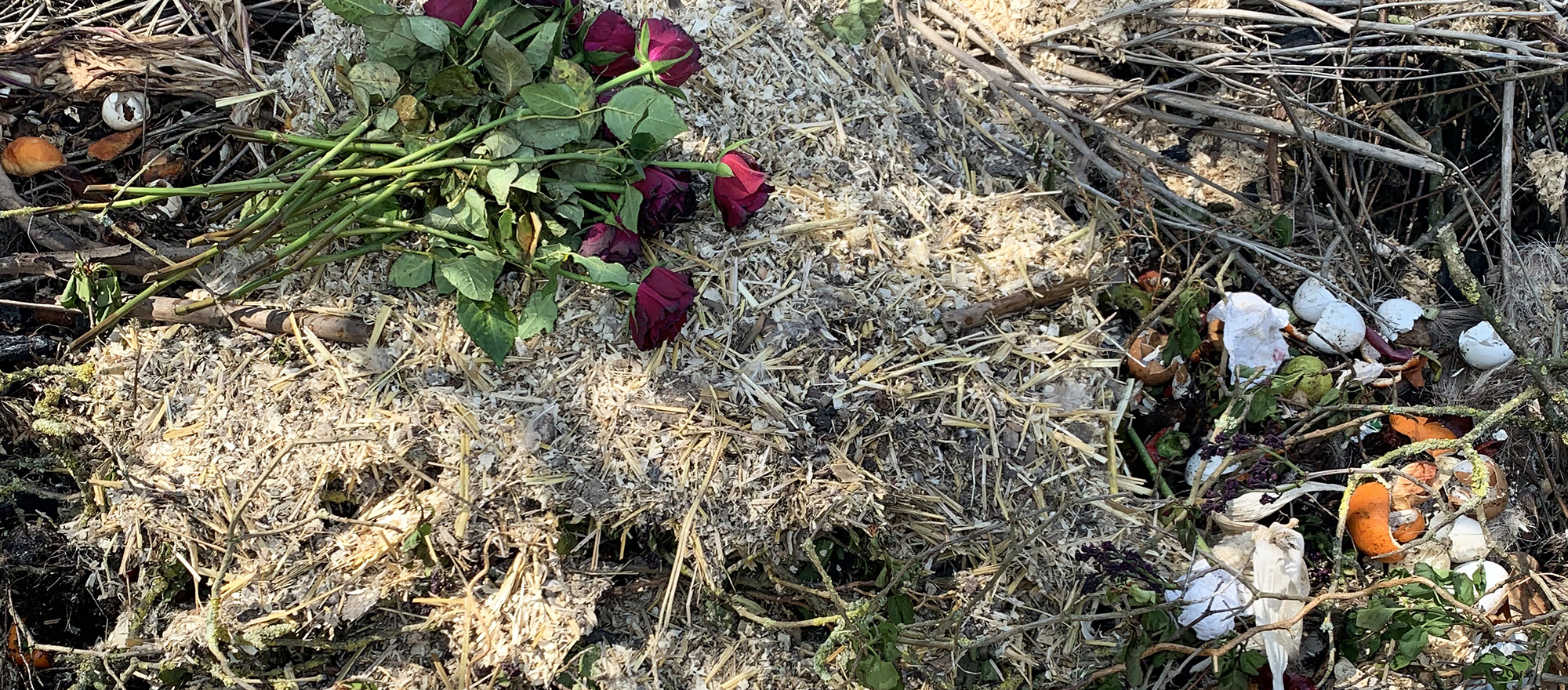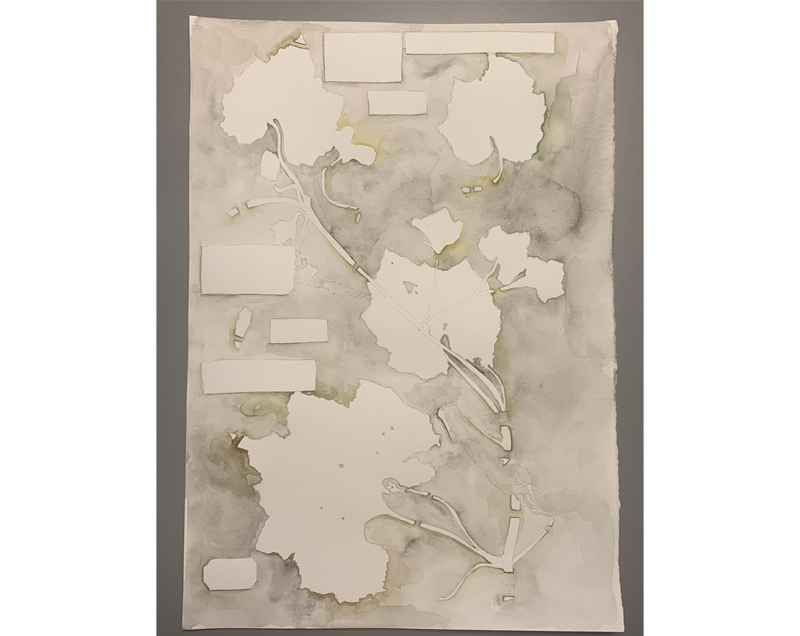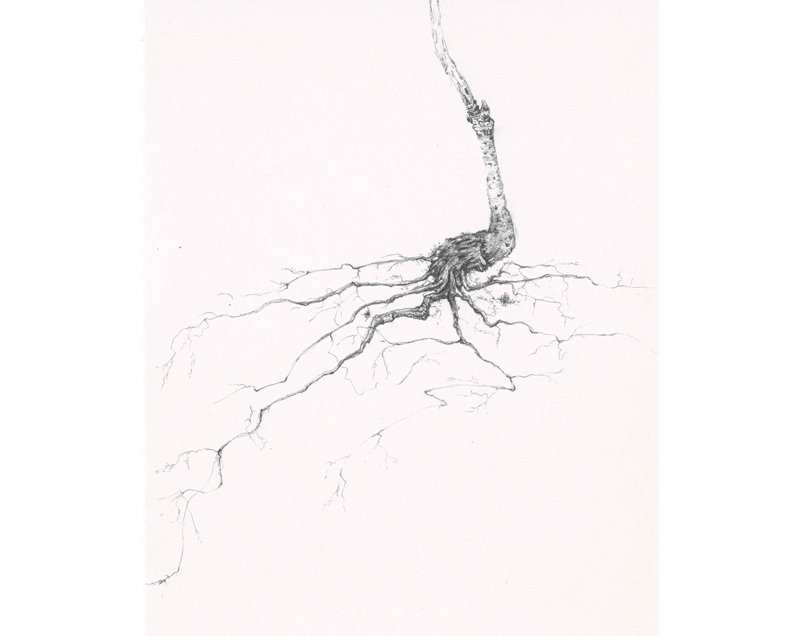
Art Talk: Amber veel
Where does a body end
and the universe begin?
Let’s take you in without any introduction. Just start reading and BANG! You’re in Amber Veels Biosphere…
There’s this pattern that I heard regularly, that the work is investigative. It’s not focussed on producing definite bodies of art. This is what they told me at Rietveld Academy at the beginning of my career and it’s still a pattern in my workspace. But that is the point for me. I am composting.
Could you explain this, composting from an artistic perspective?
Well composting in nature marks the transformation from one state of being into the next. It takes time to occur. You can’t just sit next to it and watch it happen. It’s about a different scale of time. Those that are somehow invisible to our observation. This is my workspace. I want to bring this into awareness.
There’s this hedge in my garden, it might be 80 years old. I’ll trim it regularly and the branches turn into compost which feeds the soil that feeds the hedge. It’s another kind of lifecycle.
“How this zucchini plant surrenders itself to earth
at the end of a growing season”

So ‘Museum pieces’ are not the center of your work, but you do make beautiful pieces for display
Well ofcourse. Just like the whole procedure of artisinal tanning of skins. A very beautiful and understandable procedure with a fair end product. But it’s not so much about the actual skin for me. It’s about the whole process of decay, conservation and renewall.
Those pieces are the markers of this investigation. They represent a lifeforce in my work. It’s beyond creating a piece of artistic work. In fact, I’m very interested in the story that precedes it, the invisible roam that creates this. The whole process to get to this point, to this marker as a physical materialized artwork is fascinating to me.
And this turns out in many shapes or disciplines?
At this moment I like to draw. At the Royal Drawing School of London I studied botanic plant /time. Plants have their own timescale. To capture this is challenging.
Our lifespan is say 80 years of 24 hours, it seems very lineair and then it’s over. But a tree shows a different kind of cycle. I recently read a sentence ‘ decaying is connecting’ it captured my curiousity. I see this zucchini plant in my back yard surrender itself back to the earth. There’s a little spider living in one of its crumbled leafs and there’s a rotting fruit beside the plant. It all seems so perfect, a kind of time frame I like to connect to.
“The story that precedes the work”

A continuous workflow that births provisional conclusions.
Yes, and writing seems to be a part of this as well. Although I still need to get used to that myself. They are little notes. Sometimes I post them on my Instagram, a bit casually.
I’ve always been collecting a lot and react to the things I find in different ways. I find a piece of wood that looks like a bone. So I use clay to mend it into a familiar shape while remaining tangible. Is it wood, is it bone?
You have been experimenting with conservation of animals and developed a sustainable plantbased method for tanning leather. Using road kills or slaughtered animals.
I want to conserve these animals and experience some kind of physical nearness. Wearing it on my skin or keep it with me somehow. Giving aknowledgement to its life and death. There are so many layers to look into with this.

They dissapear easily from our consciousness.
Yes and the way they were killed as well. I have a stag skin with a hole where it’s been shot causing its death. It remains such a prominent spot on the skin.
An Irish collegue artist caught a fish with a spear. He smoked the skin and meat in a slow artisan fashion with this hole still in the fillet. He found it hard to part from this and that is something I can relate to. This whole ritual of preservation makes this hole so substantial.
When holes arise in a body, raw and painful, that is a portal to step into another side. Another reality or dimension. The cutting edge of the skin, it’s so radical and invasive. It is violent. Bataille spoke about transgression. An invasive act to cross a boundary. How far can you go with this? What’s there to experience? And when is the point of no return?
Even with migraine symptoms these blind spots appear in my sight. Undergoing this transmutation from one to another reality.
With death as the ultimate portal?
It’s this rawness of these holes between dimensions that intrigue me. There is a certain kind of knowledge and respect to find there. Where does one state of being stop and another begin? Especially when an animal gets slaughered. It’s a way of transporting this animal into death and then we eat it to keep ourselves alive. This circle has a bizarre kind of beauty that is very painful as well. It can really crawl under my skin.
In Celtic and Norse mythology they know the Selkie, a people that are both seal and human. Where is the boundary? In more indigenous cultures they use animal skin to coincide with these animals. I can relate to this need.
“Again walking around with a small dead animal in my pocket while I do my groceries”

Rough spots
I can imagine that your work can trigger the attention from animal activists.
At one exhibition for Museum Boymans van Beuningen I made cuddly toys out of rabbit fur. I longed to relate to them, caress them. Some people could experience this as disrespectful. The museum was a bit wary of this. But despite many visitors there were no negative reactions.
Protesting art might not always be the right place for outrage. Works that trigger these responds usually address collective ideas and assumptions. Collective blind spots. Dealing with transiency and death and our role in this is painful. You attend to our thinking about this.
Well some kind of experience of that. As a comfort or cosmetic kind of selfcare you can use medication, meditation, yoga or scented candles to relate to these issues. But there’s also this invitation to look to the world around you. Taking care of yourself is also taking care of the animals, chicken ánd rooster alike. Caring for plants and trees.
We are an ecological system. If we’re not caring for all parts of it, it will end up hurting ourselves as well. It’s another kind of thinking. A larger system and time scale. It’s not just the reality of a 24 hours economy. It’s really about caring for the whole picture from another perspective.

Caring seems to be one of these values that became subordinated in our economic thinking. And it has historically been considered a more feminine value as well.
Women have traditionally been the caretakers that helped people into life and depart from it. The doula of birth and death, as a gate keeper. I am interested in this ritual of transition, turning from leaf into soil. Experiencing the edge, the skin. As an artist I’m searching for the essence. Sometimes by making images or as a writer. Sometimes by working in my garden. There is no real distinction, it’s all coming from the same intention.
This might be a recent distinction. Once there were these natural philosophers who were blending many fields of expertise. Universal people who studied nature and translated their knowlegde into medical, architectural, legal or artistic expertise. All in one person.
If you’d manage to remain in such a strong commited energy. In my case I sometimes falter in the fragmented reality of modern life. But that is how I translate it in my work, as a collection of puzzle pieces. All these works are like archeological findings. Shards, fragments.
A multi dimensional oeuvre.
The transition between different dimensions. Existence and decay and connecting to both. It’s about cutting through maps and time travelling. I collect so much from nature and work with this. Drawing, preparing, constructing, compiling. All those pieces together. As soon as you find words to address the undercurrent the enchantment could be lost.
It’s the pause between two heartbeats. The time in between breaths that inspire me.
More about Amber Veel
Find out more about the wonderful work and live of Amber by visiting her website Taxidermic Laboratory or her Instagram account.

Images by Amber Veel, portrait: Elisabeth Lanz Fotografie.